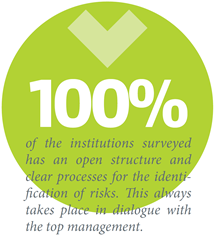All institutions have an open structure and clear processes for the identification of risks. This always takes place in dialogue with top management.
Identification
Nearly every financial institution has a written risk charter in which the institution’s position in respect of risk-taking is stated. 75% of the sector (14 out of the 19 institutions surveyed) systematically publishes this charter on the intranet and, in addition, it is often disseminated via e-mail. Some institutions go even further and provide training sessions (72% of the sector, i.e. 10 out of the 19 institutions surveyed) and/or e-learning (61% of the sector, i.e. 8 out of the 19 institutions surveyed) about their risk charter. Often, such training sessions or e-learning modules are mandatory for staff.
Febelfin Academy, the training institute of the financial sector, also offers various courses in respect of risk management. A few examples: Basel II and the transfer to Basel III, Enterprise Risk Management, Financial Risk Management or Professional Certificate in Risk Management.
Within the financial institutions, risks are continuously monitored and identified. All surveyed institutions have an open structure and clear processes for the identification of risks – in dialogue with the top management.
This is usually done using quantitative analyses of information based on mathematical risk models. In 51% of the sector (8 out of the 19 institutions surveyed) external experts are also consulted for the identification of risks.

Communication
All the surveyed institutions have set up transparent communication mechanisms where top management, the business lines and the risk manager meet to discuss the risks. During these communication moments, both the identification and the follow-up of the risks are discussed. In nearly all the surveyed financial institutions, risk measurements are also discussed. In addition, 13 out of the 19 institutions surveyed (96% of the sector) have a risk committee that operates at the level of the Belgian management board. Three fourths of the risk committees include external and independent members, and in some cases these members even constitute a majority.
78% of the banking sector (8 out of the 19 financial institutions surveyed) include in their management boards (and/or committees) more independent, external members than are mandatory. This way, conflicts of interest and abuse of power are countered. Ensuring that these independent members also have all relevant information available to perform their job properly is a constant point for attention.
